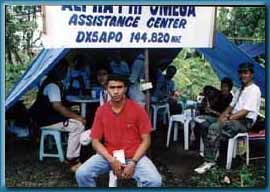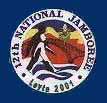|
|
|
MODULE II - OPERATING PROCEDURES
It is every ham's dream to save a life through the use of his equipment while enjoying the art of the hobby. Radio amateurs all over the world have served their countries and fellowmen in times of need. Amateur radio operators recognize this responsibility to provide emergency communications when necessary. They train and develop skills to be effective communicators in times of need. "This is one of the many important reasons why all members of C.I.R.C.L.E. 5 are encouraged to monitor the calling frequency at all times - to be on standby alert to any call for assistance, especially during an emergency situation. You will never know when an emergency may come up, and it may be only you who can give the necessary assistance."�.-4F5AWW PRINCIPLES OF EFFECTIVE EMERGENCY OPERATION 1. Keep the QRM level down. Remain silent unless called upon. There are only two reasons to check in to an emergency net: (a) You have a bonafide emergency traffic; or, (b) the Control station is requesting help that only you can provide. (See also "Keeping The QRM Level Down") 2. Monitor established emergency frequencies. Many areas have established emergency frequencies that should be monitored every now and then for possible distress call. In many instances, you learn of an existing emergency when monitoring the frequencies of other groups/agencies. 3. Familiarize yourself with the language of other radio services (such as, the "10" code which is used by the PNP, the BFP and other emergency service agencies). This knowledge becomes handy in situations when the caller is not an amateur radio operator or who is not acquainted with the Q Code. 4. Avoid spreading rumors. Transmit only facts, not speculations. Write down reports and messages "word for word" if possible. 5. Strive for efficiency. You are more effective as a part of a team than as a lone individual. 6. Use all communication channels intelligently. The object is to protect life. Use emergency or normal communication channels where available. Telephones are also useful. 7. Don't broadcast. Our job is to communicate for, not with the general public. |
|
THE ESSENTIAL EMERGENCY COMMUNICATION NETWORK 1. Command Post (CP) - is the station located where he can make personal observation of the situation. Assessment of the situation is the first function of the CP. He establishes contact with Control and calls for help, if necessary. He is the first station/operator at the scene or may be assisted by other operators (field monitors). Additional stations/operators may be needed to be located in different locations at the scene to give additional information of a situation.
2. Control - is the dispatcher in an emergency situation. He may be the club station control or the first station that acknowledges the emergency call (as temporary control) or one who is strategically located takes over as control. 3. Field Monitors - are stations/operators located at the scene to give detailed information to the Command Post. They are assigned to locations at the scene of emergency by the Command Post. They may have been already at the scene at the time the emergency occurred or they may have responded to the scene. 4. Back Up Monitors - are stations/operators who may not be located at the scene of emergency but who are capable of monitoring the situation and are ready to give assistance if needed. GENERAL PROCEDURES Once given the location and apprised of the emergency situation, the Control can dispatch additional manpower to help, equipment or other help needed by the CP. The Control then informs all stations that an emergency situation is being monitored and advises everybody to QRX for any assistance that may be needed. He then assigns tactical call signs to responding stations (i.e. Command Post, Monitor 1, Monitor 2, Mobile 1, Mobile 2, etc.). (See also "The Tactical Call Sign" in "The Call Sign") If the emergency arises during the Net Call, the net is immediately stopped. Depending on the nature and gravity of the emergency, the Control may advise all stations involved in the operation and those ready to help to QSY to the emergency frequency or any alternative frequency or attend to the emergency situation on the calling frequency without going QSY. From time to time, the Control may give updates to avoid questions from other stations that may unnecessarily interrupt the channel and the flow of emergency communication. If the emergency is over, the Control informs all stations and advises everybody to QSY to the calling frequency or resumes the Net if the emergency came up during the net call. The incident and other pertinent data are recorded by the Club Station Control in the Club Log Book for future reference. |
- When To Use the "Breaks"
- The Net Call
- Responding To Emergency Calls
- Keeping The QRM Level Down
- Signal Reports and QSL's
- QSO and Ragchew
|
|
|
Copyright �2000-2002 [email protected] -- All Rights Reserved -- Designed by WebCreations




